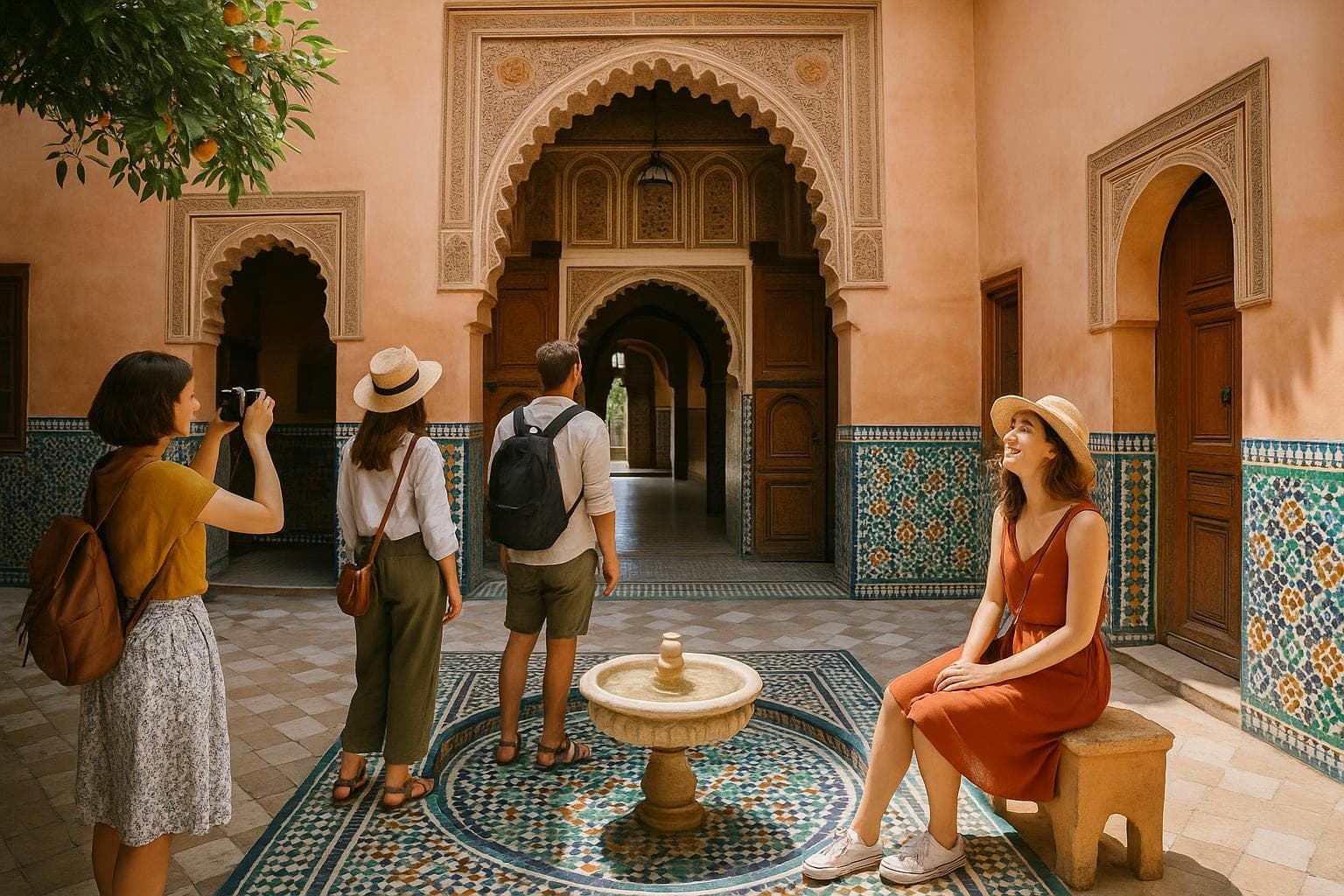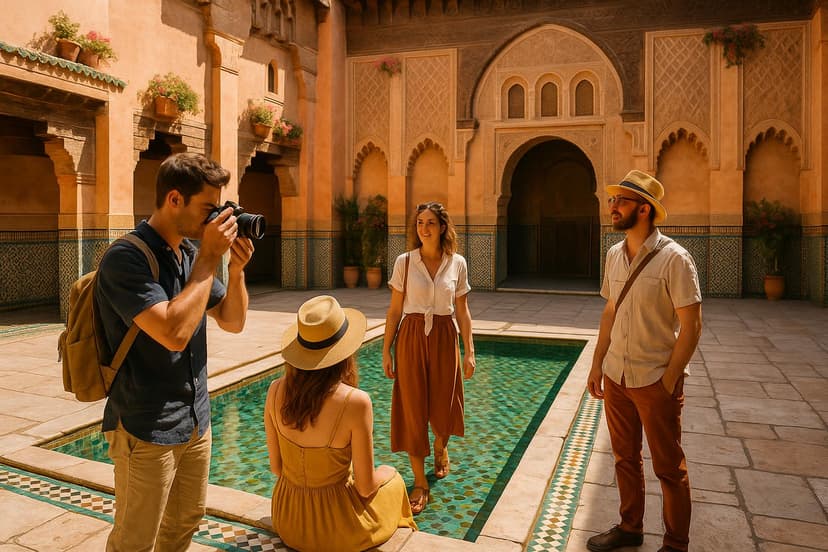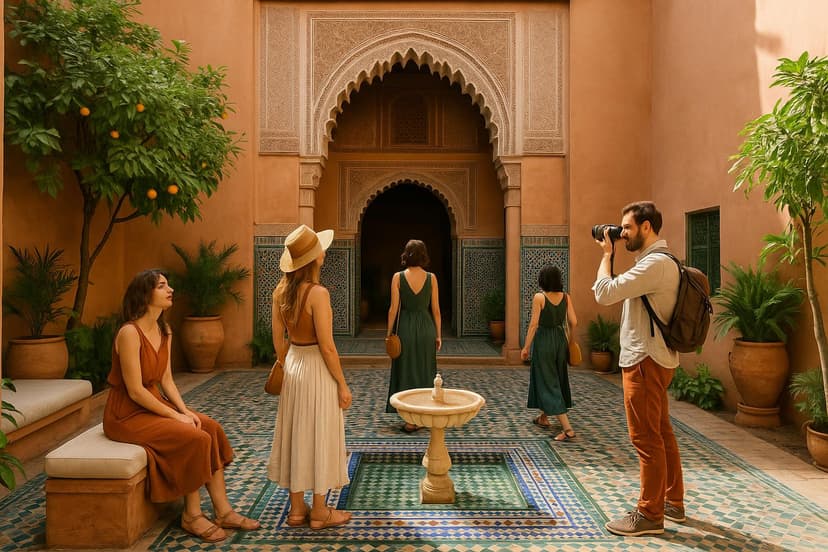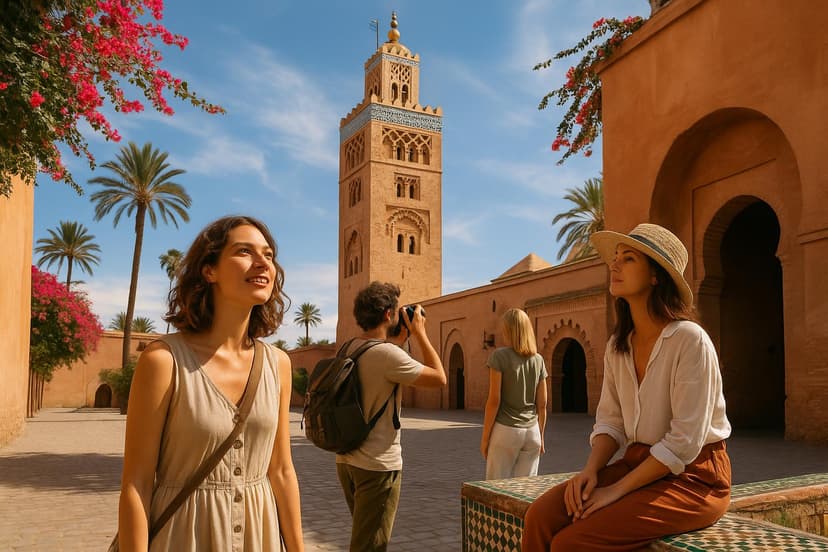A 3-day Riad Craft Trail: Zellige & Tadelakt in Marrakech

A tactile, design-led three-day trail through Marrakech’s medina and design districts focused on zellige (mosaic tile) and tadelakt (lime plaster). For design enthusiasts: studio visits, museum study of pattern and material, and hands-on workshops held in riads and artisan hubs. Planned for November (mild days, cool mornings) with realistic pacing and local insider tips.
Highlights
- Hands-on tadelakt workshop in a historic riad
- Zellige mosaic session with local craftsmen at the Ensemble Artisanal
- Study of colour and modernist inspiration at Musée Yves Saint Laurent & Jardin Majorelle
- Studio crawl through Sidi Ghanem design district and Galerie 127
- Close study of traditional Moroccan craftsmanship at Dar Si Saïd and Maison de la Photographie
Itinerary
Day 1
Medina foundations: material study in museums and artisan stalls; first contact with zellige patterns and tadelakt surfaces.
Dar Si Saïd — Museum of Moroccan Arts: study carved wood, plaster and tile
Begin in the medina with a focused study of traditional craft materials: carved cedar, painted zellige panels, and historic tadelakt finishes in an intimate museum setting.
Local tips:
- Timing & light: Visit mid-morning to see surfaces under soft, even daylight — ideal for photographing glaze variations without harsh shadows.
- Access note: The museum sits in a historic house with uneven floors and stairs — bring stable footwear and plan for limited wheelchair access.
- Ask the guard/curator to point out repair traces on plastered walls — these visible seams are invaluable for understanding traditional tadelakt repair techniques.
Le Jardin Secret — courtyard architecture and zellij close-up
Short walk to this restored riad-garden complex to study courtyard geometry, tile banding, and tadelakt-coated niches up close.
Local tips:
- Texture study: Kneel (respectfully) at lower fountain levels to examine tile joins and mortar depth — perfect for noting grout profiles and tile thickness.
- Photography: The north-facing areas in November give a cool, neutral light that renders ceramic glazes realistically — bring a polariser for reflections.
- Practical: The medina alleys are narrow; large sketchbooks are easier to manage than tripods. Carry small swatches or a notebook for rubbing textures (ask first).
Lunch — Café des Épices: rooftop views and pattern reading
A light, design-minded lunch with medina rooftop views — good time to sketch patterns and swap observations about proportions.
Local tips:
- Seating note: Ask for a shaded rooftop table to study surrounding façades and rooftop tiling at eye level.
- Menu & pace: Keep lunch light (salads or mezze) to leave energy for an afternoon of hands-on visits.
- Networking: This is a good spot to send messages to local studios (many reply faster after midday) and confirm any same-day artisan visits.
Ensemble Artisanal de Marrakech — stalls, small workshops, tile vendors
Explore the state-run artisan complex where small workshops and sellers display zellige fragments, dyed pigments, and plaster samples — a pragmatic place to acquire material samples.
Local tips:
- Sample collecting: Ask vendors for small offcuts or rejected tiles — these are often sold cheaply and are perfect tactile study pieces.
- Haggling: Be respectful but expect to negotiate; bring small notes and coins for quick purchases of material samples.
- Logistics: The complex can be cooler in November afternoons; keep glazed tiles in a rainproof bag if weather turns.
Riad pause — Rest, collate sketches and samples
Return to your riad to sort photos, lay out collected tile fragments, and plan questions for studio visits. Short rest to beat the late-afternoon chill.
Local tips:
- Stair note: Many riads have central courtyards and stairs — if you have heavy samples, ask staff for help to move them to your room.
- Review session: Use this quiet hour to make annotated sketches of tile repeats and plaster tones while memory is fresh.
- Curing observation: If you bought small plaster samples, avoid storing them in humid bathrooms overnight — lay them flat in the riad’s heated living area.
Evening dinner — Nomad rooftop: contemporary Moroccan design and a view
Dine on a modern rooftop terrace with clear sightlines across the medina — an opportunity to compare historic rooftops with contemporary interventions.
Local tips:
- Seating & light: Book a sunset slot; November sunsets are early (around 17:50) and golden light highlights tile sheen across the medina.
- Material note: Observe contemporary material choices (metal balustrades, glazed tiles) used in rooftop renovations for inspiration.
- Conversation starter: Ask staff about their favorite local craft shops — rooftop restaurants often work directly with small ceramic studios.
Day 2
Modern design and maker district: museums of colour, Majorelle’s palette, then Sidi Ghanem studio crawl and a hands-on tadelakt session in a riad.
Musée Yves Saint Laurent Marrakech — modern colour & textile references
Study YSL’s relationship with Moroccan colour, tile patterns and the use of strong fields of colour — essential reference for contemporary designers.
Local tips:
- Lighting & palette: The museum lighting is curated; photograph fabrics and key objects with a neutral white balance to capture true pigment.
- Timed entry: Book the earliest slot possible in November to avoid crowds and to see the gardens with morning light for colour cross-references.
- Contextual note: While YSL is modernist in approach, focus on material translations — note how tiles and plaster inform garment textures.
Jardin Majorelle — chromatic study in plant and tile
Walk the adjacent Majorelle gardens to study Yves Saint Laurent’s cobalt blue and the garden’s interplay with soil, ceramics and tiled surfaces.
Local tips:
- Colour swatches: Bring a small swatch book or phone app to capture ‘Majorelle blue’ under morning light for accurate colour notes.
- Crowd tip: Even in November it draws visitors—stick to side paths to examine urns, tiled floors, and painted surfaces closely.
- Weather note: Mornings are cool; the shaded garden is ideal for studying glaze under diffuse light without glare.
Lunch — Le Jardin: a restaurant/gallery to compare contemporary locale uses
A relaxed lunch inside a restored riad with contemporary design interventions — good for discussing material translations and sourcing.
Local tips:
- Seats & study: Request a table near the interior courtyard to study plaster finishes and painted motifs used in the restaurant's restoration.
- Pacing: Keep lunch measured so you have energy for the studio crawl this afternoon; discuss supply-chain questions with staff if possible.
- Sample sourcing: Ask staff where they sourced particular tiles or fabrics — hospitality spaces often work with local ateliers and can share contacts.
Sidi Ghanem — design district studio crawl (showrooms & small workshops)
Transfer to Sidi Ghanem to visit contemporary showrooms and makers: modern ceramics, furniture studios and Galerie 127’s contemporary exhibitions.
Local tips:
- Studio appointments: Contact key studios in the morning (Galerie 127 and nearby showrooms) — many open late and appreciate brief email confirmations.
- Transport: Use a short taxi from the medina (15–25 min). In November the drive is pleasant; bring a scarf for cool breezes between studios.
- Note-taking: Carry a portable scale/ruler and small camera to log proportions and joinery details in studios (ask before photographing interiors).
Galerie 127 — contemporary art that crosses into craft
Visit this influential contemporary gallery to see how modern Moroccan artists deploy traditional motifs and materials into new forms.
Local tips:
- Curatorial insight: Ask the gallery attendant for any past shows that used zellige or lime-based works — galleries often archive installation photos useful for study.
- Accessibility: Gallery spaces may be tight; schedule a quieter late-afternoon slot for close examination of works.
- Buying & leads: Galleries frequently collaborate with makers — ask for contacts of ceramicists or tadelakt artists who worked on exhibited pieces.
Hands-on tadelakt workshop — supervised session at a riad
A private, practical tadelakt session in a riad setting where you learn lime preparation, application, burnishing and natural soap polishing under a local craftsman.
Local tips:
- Clothing & kit: Wear comfortable clothes you don't mind getting dusty; bring closed shoes and thin nitrile gloves if you have sensitive skin.
- Curing & timeline: November’s milder temperatures are perfect for learning tadelakt — avoid wetting the surface too much; ask the master about local curing times.
- Riad logistics: Many riads have narrow stairs—if you have mobility issues, request a ground-floor space for the workshop when booking.
Day 3
Deep practical craft day: zellige mosaic making, meeting cooperative artisans, photography study, and a closing design dinner.
Zellige mosaic workshop — hands-on session at the Ensemble Artisanal area
A focused morning workshop learning the geometric layout, cutting, and setting of traditional zellige tiles — take home a small assembled sample panel.
Local tips:
- Tool orientation: Expect to use hand tools for cutting — bring protective eyewear if you prefer, and ask for demonstrations before trying cuts yourself.
- Sample panel: Request a small framed sample (20x20 cm) as a take-home; it’s a practical souvenir and a tactile study piece.
- Timing & humidity: November is ideal for setting grout — cooler mornings mean grout sets slowly, giving you time to refine joints; plan travel for drying time if flying soon after.
Lunch — Le Foundouk: rooftop reflections on pattern and form
A relaxed, design-rich lunch in a converted house — use the time to compare profiles of tile joints and plaster finishes recorded during the morning.
Local tips:
- Rooftop views: Book a table with a courtyard view to compare restoration choices on nearby facades and roofs.
- Sample review: Lay out your morning’s sample panel on the table to discuss finishing techniques with peers or hosts.
- Seasonal menu: November menus are heavier; pick lighter mezzes to keep energy for afternoon museum visits.
Dar Bellarj Foundation — small exhibitions and artisan-led programs
Visit this cultural foundation to view temporary shows, meet curators and discover initiatives that link traditional craft with contemporary design projects.
Local tips:
- Programming: Ask in advance about any afternoon talks or demonstrations — foundations often run artisan meetups ideal for making professional contacts.
- Access & workshops: Spaces can be on multiple levels with narrow stairs; request assistance if you have mobility concerns.
- Research tip: Collect printed materials or flyers — these often list names of collaborating ateliers and contact details not widely published online.
Maison de la Photographie — archival study of pattern, portrait and material
A late-afternoon visit to study photographic archives that document interiors, artisans and the evolution of Moroccan decorative language — useful for research and mood-boarding.
Local tips:
- Composition study: Use the archive prints to study how craftsmen and interiors were framed historically—note angles useful for photographing tile installations.
- Lighting: The dimmer interior light in November is ideal for viewing framed prints; use a handheld loupe or a camera with good low-light capability for details.
- Contact: Curators may provide references to families of craftsmen across generations — ask for names to follow up studio visits.
Closing dinner — La Famille: a creative, low-key setting to collate findings
Finish with an intimate, creative dinner where you share sketches, photos, and samples. Use the evening to swap contacts and make a short action plan for follow-up research or commissions.
Local tips:
- Curate the conversation: Reserve the table in advance and set aside a small area to spread out sketches and small samples for group discussion.
- Local contacts: Ask restaurant staff for recommendations of local designers or small galleries that may accept commissions.
- Packing tip: If you have tile or plaster samples, wrap them in cloth and carry them in hand luggage — November flights can still have variable hold conditions.
More options in Marrakech
Explore more travel plans and guides for Marrakech.




